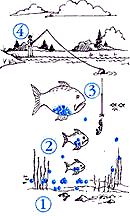By Ellen Kuwana
Neuroscience for Kids Staff Writer
July 23, 2004
 Mercury is a naturally occurring heavy metal. It
is also a result of industrial pollution: coal-fired power plants in the
US spew 48 tons of
mercury into the atmosphere each year. The mercury from the air
settles into the soil and rivers, where it is converted by bacteria into
methylmercury. It is this form of mercury that is
particularly dangerous to animals, including humans.
Mercury is a naturally occurring heavy metal. It
is also a result of industrial pollution: coal-fired power plants in the
US spew 48 tons of
mercury into the atmosphere each year. The mercury from the air
settles into the soil and rivers, where it is converted by bacteria into
methylmercury. It is this form of mercury that is
particularly dangerous to animals, including humans.
 In March 2004, the US Food and Drug Administration (FDA) and Environmental Protection Agency (EPA)
issued a joint consumer advisory about mercury in seafood. Researchers
measured methylmercury levels in the tissues of various fish and
shellfish. Fish at the top of the food chain tend to live longer. The
combination of eating other fish and living a long life leads to a higher
mercury build-up in their tissue. Four types of fish (swordfish, king mackerel, shark and tilefish) were shown
to have mercury levels high enough to cause damage to a developing baby's
brain. Therefore, pregnant and nursing women should not eat these types
of fish.
In March 2004, the US Food and Drug Administration (FDA) and Environmental Protection Agency (EPA)
issued a joint consumer advisory about mercury in seafood. Researchers
measured methylmercury levels in the tissues of various fish and
shellfish. Fish at the top of the food chain tend to live longer. The
combination of eating other fish and living a long life leads to a higher
mercury build-up in their tissue. Four types of fish (swordfish, king mackerel, shark and tilefish) were shown
to have mercury levels high enough to cause damage to a developing baby's
brain. Therefore, pregnant and nursing women should not eat these types
of fish.
The Association of Reproductive Health Professionals recommends women
of childbearing age and children should limit seafood intake to one
serving (6 ounces) per week of the following fish: fresh or canned
albacore tuna, grouper, marlin, bluefish and orange roughy. These
recommendations are based on mercury levels and the level of contaminants
such as PCBs, which
also impair development and functioning of the nervous system. The
government advises that people (pregnant women included) limit intake of
seafood to 12 ounces (340 grams, or 2 average meals) of low-mercury
seafood per week. Low-mercury seafoods include shrimp, salmon, pollock,
catfish, monkfish, bass, trout, cod, haddock, tilapia and canned light
tuna. (Albacore "white" tuna has higher mercury levels than canned light
tuna.) It is recommended that people eat a variety of seafood, not just
one type.
 Although all seafood has trace levels of mercury,
there are many benefits to eating seafood. For example, the omega-3 fatty
acids that are found in fish help prevent heart disease and improve
symptoms of psychiatric disorders such as depression,
schizophrenia, bipolar
disorder and possibly attention deficit hyperactivity disorder. British
researchers have shown that children who are given capsules of omega-3
fatty acids improve in their schoolwork. Although all seafood has trace levels of mercury,
there are many benefits to eating seafood. For example, the omega-3 fatty
acids that are found in fish help prevent heart disease and improve
symptoms of psychiatric disorders such as depression,
schizophrenia, bipolar
disorder and possibly attention deficit hyperactivity disorder. British
researchers have shown that children who are given capsules of omega-3
fatty acids improve in their schoolwork.
 Mercury is known to damage the nervous system. A mother who is
exposed to mercury passes it on to her unborn child; similarly, mercury
can be passed to a baby from the mother's breast milk. Problems with
memory, attention and language have been documented in children who were
exposed to "moderate levels" of mercury while in the womb. Mercury
exposure can lead to cognitive impairment, blindness, seizures, kidney
damage, as well as general problems with the nervous system and digestive
system. Young children are more sensitive to the effects of mercury than
adults. Therefore, pregnant women (or women considering getting pregnant),
children and nursing mothers should be especially careful about how much
and what type of seafood they eat. Many people will be happy to know that
fish sticks and most fast food fish sandwiches are made with fish that are
low in mercury. Mercury is known to damage the nervous system. A mother who is
exposed to mercury passes it on to her unborn child; similarly, mercury
can be passed to a baby from the mother's breast milk. Problems with
memory, attention and language have been documented in children who were
exposed to "moderate levels" of mercury while in the womb. Mercury
exposure can lead to cognitive impairment, blindness, seizures, kidney
damage, as well as general problems with the nervous system and digestive
system. Young children are more sensitive to the effects of mercury than
adults. Therefore, pregnant women (or women considering getting pregnant),
children and nursing mothers should be especially careful about how much
and what type of seafood they eat. Many people will be happy to know that
fish sticks and most fast food fish sandwiches are made with fish that are
low in mercury.
 Some folk remedies and rituals use mercury in the form of metallic
droplets, which are typically stored in a sealed pouch. Sold as
"azogue" in stores called "botanicas," the mercury is used
in rites of Esperitismo (from Puerto Rico), Santeria (Cuban-based) and
voodoo. The mercury is sprinkled into bathwater, perfume, devotional
candles, or placed in the home or car. Short- and long-term use is
hazardous, and damage can be done before any symptoms appear.
Some folk remedies and rituals use mercury in the form of metallic
droplets, which are typically stored in a sealed pouch. Sold as
"azogue" in stores called "botanicas," the mercury is used
in rites of Esperitismo (from Puerto Rico), Santeria (Cuban-based) and
voodoo. The mercury is sprinkled into bathwater, perfume, devotional
candles, or placed in the home or car. Short- and long-term use is
hazardous, and damage can be done before any symptoms appear.
For more information about seafood and mercury, see resources and
references below, or call 1-888-SAFEFOOD (the US
FDA). |


![[email]](./gif/menue.gif)


